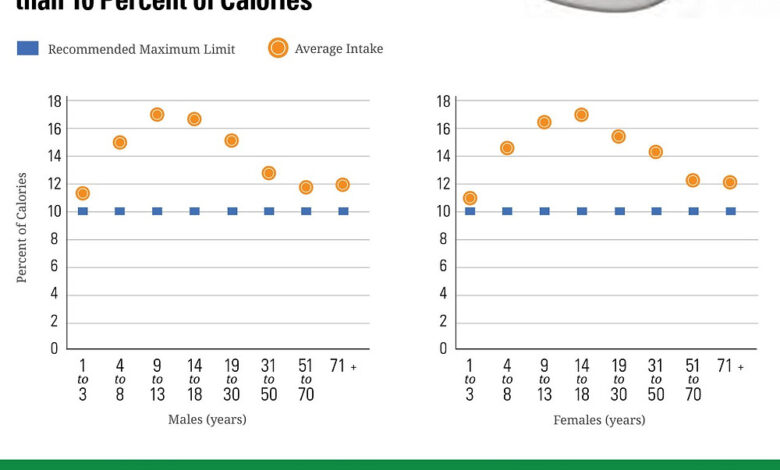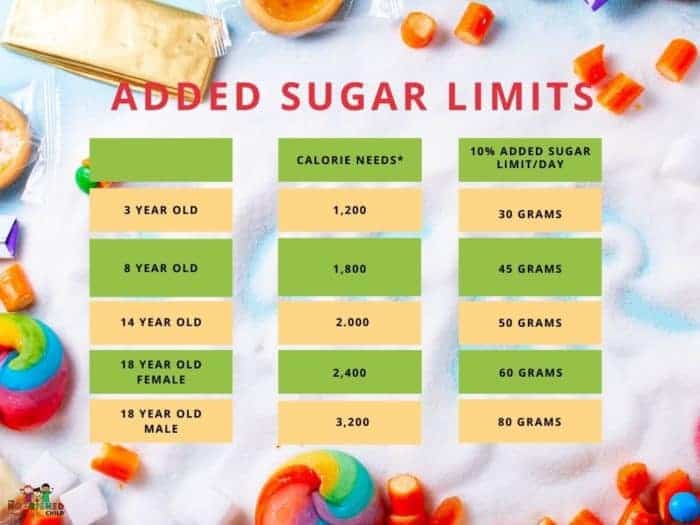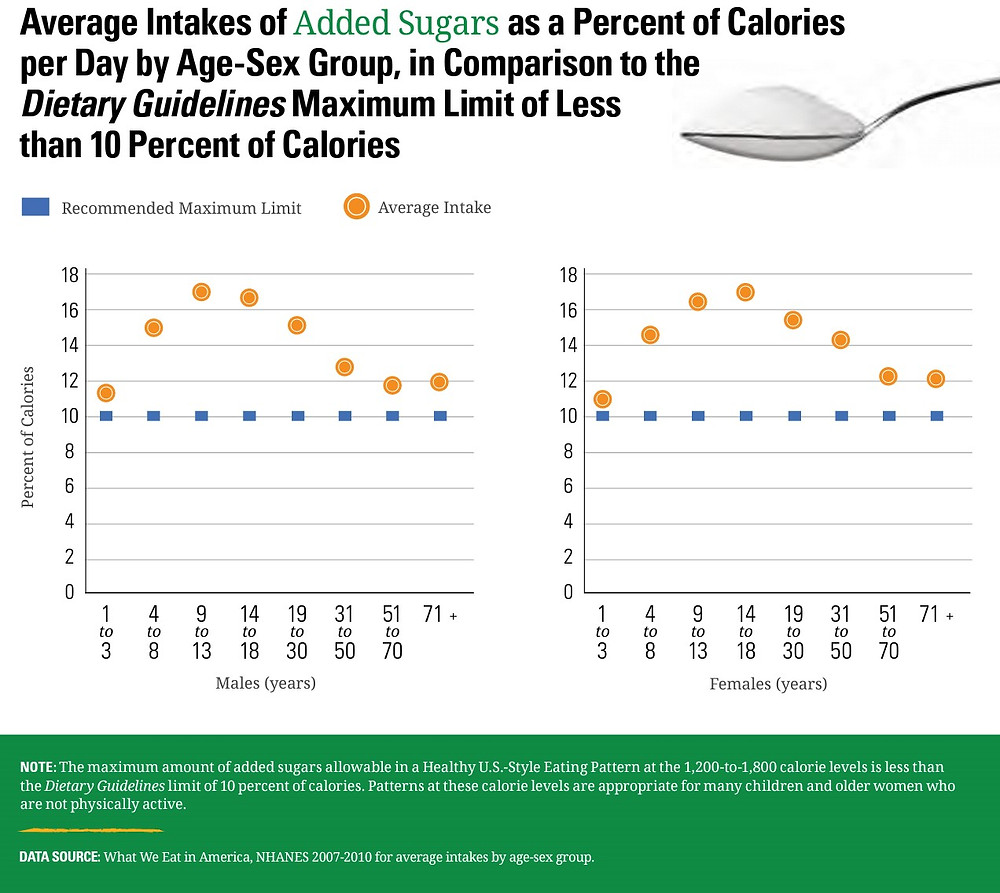
Toddlers eating more sugar than recommended for adults is a growing concern. Many toddler foods and drinks are surprisingly high in sugar, often exceeding the recommended daily intake for even adults. This isn’t just a matter of a sweet tooth; excessive sugar intake can have detrimental effects on a child’s developing body and mind. We’ll explore the problem in detail, examining the causes, health impacts, and potential solutions.
From hidden sugars in seemingly healthy foods to the persuasive marketing tactics aimed at young children, this post delves into the multifaceted reasons behind this worrying trend. We’ll look at the different types of sugar present in common toddler foods and beverages, compare their sugar content, and analyze how these choices impact a toddler’s health. Ultimately, the goal is to equip parents with knowledge and strategies to navigate this complex issue.
Defining the Problem

Toddlers are naturally curious and eager to explore the world around them, including the delicious variety of foods available. However, understanding the appropriate amount of sugar in their diets is crucial for their healthy development. Excessive sugar intake can have detrimental effects on their growing bodies and minds, and it’s essential to guide them toward a balanced diet.The recommended daily sugar intake for toddlers is significantly lower than for adults.
This is because a toddler’s metabolism and developing organs are still adjusting and have different nutritional needs compared to an adult. While there isn’t a universally agreed-upon single number for the recommended sugar intake for toddlers, it’s generally recommended to limit added sugars to a small portion of their daily caloric intake. This is often expressed as a percentage, rather than a specific number of grams.
Recommended Daily Sugar Intake for Different Age Groups
The American Heart Association (AHA) provides guidelines for added sugar intake. For children and adults, they recommend limiting added sugars to less than 10% of daily calories. However, this percentage is often significantly higher in toddler diets, particularly if they consume a lot of processed foods and sugary drinks.
Potential Health Consequences of Excessive Sugar Intake in Toddlers
Excessive sugar intake in toddlers can lead to various health problems. These include increased risk of tooth decay, weight gain and obesity, and potentially impacting their energy levels and concentration. Furthermore, excessive sugar intake can disrupt the delicate balance of essential nutrients in a toddler’s diet, impacting their overall growth and development. This can manifest in various ways, including developmental delays or behavioral issues.
Types of Sugar in Common Toddler Foods and Beverages
Toddlers often encounter sugar in various forms, not just from obvious sources like candy. Many seemingly healthy foods and beverages contain hidden sugars. Common sources include fruit juices, sweetened yogurts, cereals, and even some seemingly healthy snacks. Understanding the different types of sugar is essential for making informed choices. These include naturally occurring sugars found in fruits and vegetables, as well as added sugars found in processed foods.
Comparison of Sugar Content in Common Toddler Foods
| Food Item | Approximate Sugar Content (per serving) |
|---|---|
| Fruit Juice (100ml) | 5-10g |
| Yogurt (1 cup) | 10-15g |
| Breakfast Cereal (1 cup) | 5-15g |
| Cookies (2 cookies) | 10-20g |
| Fruit (1 cup) | 5-15g (naturally occurring sugar) |
This table provides a general comparison, and the exact sugar content can vary based on the specific brand and preparation of the food item. It’s crucial to check labels carefully to gain a better understanding of the sugar content in the products your child consumes.
Causes and Contributing Factors

Toddlers’ sugar intake often exceeds recommended levels for adults due to a complex interplay of factors. Understanding these causes is crucial for developing effective strategies to guide healthier dietary habits in this age group. From parental influence to the persuasive power of marketing, several forces shape a toddler’s sugar consumption. This section will explore these influences, highlighting the importance of recognizing and addressing them.Parental choices and marketing strategies significantly impact a toddler’s sugar intake.
Toddlers, lacking the cognitive abilities to fully understand the implications of their choices, rely heavily on the adults around them. This makes parental influence a critical factor. Moreover, sophisticated marketing tactics aimed at this demographic often feature appealing visuals and enticing flavors, potentially contributing to an unhealthy preference for sugary products.
Parental Influence on Sugar Intake
Toddlers learn and mimic the behaviors of their parents. If parents regularly consume sugary drinks or snacks, toddlers are more likely to develop similar preferences. This modeling effect can have a lasting impact on their dietary habits. Furthermore, the ease of access to sugary foods and drinks in the home environment can also influence intake. If sugary snacks are readily available, a toddler is more prone to consuming them.
Parents who prioritize healthy alternatives and limit access to sugary treats can effectively guide their child towards healthier choices.
Marketing Strategies Targeting Toddlers
Marketing strategies play a significant role in shaping a toddler’s food preferences. Many sugary products are marketed to toddlers with colorful packaging, catchy jingles, and cartoon characters. These strategies leverage the child’s limited understanding of nutritional value and create a positive association with the product. This tactic aims to make sugary foods seem appealing and desirable. This powerful marketing influence can shape a child’s taste preferences, making it more difficult to introduce healthier alternatives later on.
Impact of Toddler’s Developmental Stages
Toddlers’ developmental stages significantly impact their preferences for sugary foods. During this period, their taste buds are still developing and their sense of sweetness is often heightened. This heightened sensitivity to sweetness can lead to a preference for sugary foods. Additionally, toddlers are often driven by immediate gratification, making them more susceptible to the allure of sugary treats, which often provide a quick and noticeable reward.
Understanding this developmental stage is essential in creating strategies to encourage healthier choices.
Table of Marketing Strategies Targeting Toddlers with Sugary Products
| Marketing Strategy | Description |
|---|---|
| Colorful Packaging | Bright colors and appealing designs on packaging attract attention and make the product more visually appealing to toddlers. |
| Catchy Jingles/Slogans | Repeated, catchy tunes and phrases create positive associations with the product and encourage repeated consumption. |
| Cartoon Characters | Associating the product with popular cartoon characters creates a positive image and makes the product more appealing to toddlers. |
| Limited-Edition Promotions | Creating a sense of urgency and exclusivity around a product, especially through temporary offers, encourages purchase. |
| Free Samples/Gifts | Providing free samples or small gifts with purchases creates a positive experience and encourages future consumption. |
Impact on Toddler Health
A toddler’s developing body and brain are particularly vulnerable to the effects of excessive sugar intake. Unlike adults, toddlers’ systems haven’t fully matured, making them more susceptible to the negative consequences of consuming more sugar than recommended. This period of rapid growth and development is crucial, and nutritional choices significantly impact long-term health outcomes.Excessive sugar intake can disrupt the delicate balance of nutrients needed for optimal growth and development, potentially leading to various health issues.
The impact of excessive sugar in toddlers differs significantly from its impact on adults, primarily due to the immaturity of their physiological systems.
It’s a bit alarming that toddlers are consuming more sugar than the recommended daily intake for adults! This definitely needs addressing. But, looking after your own well-being is key too, and incorporating the napercise trend into your routine could be a game-changer. The napercise trend and what it can do for you explores the benefits of this approach, which might help you find ways to manage stress and boost your energy levels.
Ultimately, focusing on healthy habits for both kids and adults is crucial for a balanced lifestyle, and that includes mindful sugar consumption.
Physical Impacts of Excessive Sugar
Excessive sugar consumption can significantly contribute to obesity in toddlers. A diet high in sugary drinks and snacks often leads to an energy surplus, resulting in the accumulation of excess fat. This excess weight can put a strain on developing joints and organs, increasing the risk of chronic health problems later in life. For example, a toddler consistently consuming sugary cereals and juice drinks may gain weight faster than their peers, putting them at risk of becoming overweight or obese.
Dental Problems
Frequent consumption of sugary foods and drinks can lead to dental caries (cavities) in toddlers. The bacteria in the mouth feed on sugar, producing acids that erode tooth enamel. This can result in painful cavities, impacting the toddler’s ability to eat and potentially requiring extensive dental work.
Behavioral Problems
The link between sugar intake and behavioral issues in toddlers is a complex area of study. While definitive causal links are difficult to establish, some studies suggest a correlation between high sugar intake and increased hyperactivity or mood swings. The sudden spikes and crashes in blood sugar levels from consuming sugary foods can impact mood and energy levels.
For instance, a toddler who regularly consumes sugary snacks might exhibit increased irritability and difficulty focusing on tasks.
Cognitive Impacts
The relationship between sugar consumption and cognitive development is still under investigation. While there’s no conclusive evidence that excessive sugar directly causes cognitive impairments, a diet high in sugar might indirectly affect brain development by disrupting the absorption of essential nutrients. Studies show a link between poor diets high in sugar and decreased performance in cognitive tests, potentially impacting learning and development.
Comparison of Effects in Toddlers vs. Adults
Toddlers’ bodies are still developing, making them more vulnerable to the negative impacts of excess sugar. Their metabolism is less efficient at processing large amounts of sugar, and their immune systems are not fully mature, increasing their risk of infections. Adult bodies, on the other hand, are better equipped to handle fluctuating sugar levels, but long-term excessive sugar intake can still lead to chronic health issues.
Correlation Between Sugar Intake and Health Issues in Toddlers
| Sugar Intake Level | Potential Health Issues |
|---|---|
| High | Obesity, dental caries, behavioral problems, potential cognitive impacts |
| Moderate | Increased risk of obesity, minor dental issues, potential mood swings |
| Low | Lower risk of obesity, healthy teeth, improved mood and focus |
This table highlights the correlation between varying levels of sugar intake and potential health outcomes in toddlers. It is crucial to maintain a balanced diet for optimal health and development.
Strategies for Moderating Sugar Intake
Helping toddlers enjoy a balanced diet without excessive sugar is crucial for their long-term health. It’s a common concern for parents as toddlers are often drawn to sugary treats and drinks. We need to understand that moderation is key, not complete elimination. The goal is to guide them towards healthier choices while ensuring they still experience the joy of food.Effective strategies for parents involve proactive choices, thoughtful planning, and consistent routines.
It’s alarming how much sugar toddlers are consuming, often exceeding the recommended daily intake for adults. This isn’t just about cavities; research suggests a potential link between excessive sugar intake and other health concerns, like the concerning rise in melanoma rates among young women. For example, check out this fascinating article on heres why melanoma rates have increased 800 for young women.
While the exact relationship remains complex, it’s crucial to consider the potential long-term effects of early sugar exposure on overall health.
It’s not about deprivation, but about mindful introductions to different flavours and textures. This approach allows for a healthy relationship with food, setting the stage for a lifetime of well-being.
Reading Food Labels
Understanding the sugar content in processed foods is essential. Food labels provide valuable information about ingredients, including sugar content, and allow parents to make informed choices. This includes comparing different products and selecting options with lower sugar content. Pay close attention to hidden sugars, such as those listed as corn syrup, sucrose, or high-fructose corn syrup.
Choosing Healthier Alternatives
Sweet treats are often associated with enjoyment. By replacing sugary snacks with healthier alternatives, parents can satisfy their toddlers’ cravings without compromising their nutritional needs. For example, fruit slices, whole-grain crackers with avocado, or plain yogurt with berries offer natural sweetness and vital nutrients. A simple switch can significantly impact sugar intake.
Nutritious Toddler Food Options
Many nutritious foods naturally satisfy a toddler’s desire for sweetness without the excess sugar. Examples include fresh fruits (berries, apples, bananas), vegetables (carrots, cucumbers, bell peppers), and whole-grain cereals. These options are not only low in sugar but also provide essential vitamins and minerals. The variety of colours and textures can also enhance the toddler’s enjoyment of meals.
Portion Control
Controlling portions is vital for managing sugar intake. Toddlers’ stomachs are small, so even a seemingly small amount of sugary food or drink can be a significant contributor to their daily sugar intake. Offering smaller portions and using appropriate serving sizes can make a considerable difference. This also allows for the exploration of different foods without overloading the toddler’s system.
Comparing Fruit Juice and Alternatives
| Fruit Juice | Sugar Content (grams per 100ml) | Healthier Alternative | Sugar Content (grams per 100ml) |
|---|---|---|---|
| Apple Juice (100% fruit juice) | 10-12 | Sliced Apples | Naturally low |
| Orange Juice (100% fruit juice) | 10-12 | Orange slices | Naturally low |
| Mixed Fruit Juice | 12-15 | Fruit Salad | Naturally low |
| Fruit Punch | 15-20 | Water with sliced fruits | 0 |
The table above highlights the significant difference in sugar content between fruit juices and healthier alternatives. Opting for whole fruits or water with sliced fruits is a healthier approach, ensuring that toddlers receive the nutritional benefits of fruits without an overload of sugar.
Role of Food Manufacturers and Regulations
Parents are often caught in a difficult position when it comes to limiting added sugar in their toddler’s diet. While they strive to make healthy choices, the prevalence of sugary foods marketed towards children can make it challenging to avoid excessive intake. This section examines the crucial role food manufacturers play in shaping these choices and the existing and potential regulatory frameworks that could influence them.Food manufacturers hold a significant responsibility in curbing the sugar content of products marketed towards toddlers.
Their choices directly impact children’s health and long-term well-being. From advertising tactics to product formulations, manufacturers have the power to offer healthier alternatives without compromising on taste and appeal. A shift towards healthier ingredients and portion sizes is essential for promoting healthier eating habits in young children.
Manufacturer Responsibility in Reducing Sugar Content
Food manufacturers have a significant responsibility to prioritize the health of young consumers. This includes reformulating products with reduced sugar content while maintaining palatability. Transparency in ingredient lists and nutritional information is also crucial. By focusing on naturally sweet ingredients and healthier alternatives, manufacturers can create products that satisfy children’s taste preferences without compromising their well-being.
Existing Regulations Regarding Sugar Content, Toddlers eating more sugar than recommended for adults
Current regulations on sugar content in toddler food products vary across jurisdictions. While some regions have specific guidelines for the amount of added sugar allowed in foods marketed towards children, others lack comprehensive regulations. The absence of uniform standards can lead to inconsistencies in product formulations and potential health risks.
Potential Strategies to Improve Regulations
Strengthening regulations and guidelines for toddler food products is crucial. One strategy is to establish stricter limits on the amount of added sugar permitted in these products. Another approach is to mandate clear and comprehensive labeling, making it easier for parents to understand the nutritional content of the foods they purchase. A third strategy involves supporting research on the effects of sugar on developing brains and bodies.
How Government Regulations Influence Manufacturer Choices
Government regulations directly influence the choices of food manufacturers. Clearer guidelines on sugar content and labeling requirements can encourage manufacturers to reformulate their products and offer healthier options. Stringent enforcement of existing regulations and the implementation of new, more comprehensive standards can promote a shift towards healthier products.
Table: Current Regulations and Potential Improvements for Toddler Food
| Aspect | Current Regulations (Example) | Potential Improvements |
|---|---|---|
| Sugar Content Limits | Varying, often lacking specific limits for toddler products. | Establish clear and consistent limits on added sugar across all toddler food products. |
| Labeling Requirements | May be insufficient or unclear about sugar content in relation to other ingredients. | Mandate detailed nutritional information, including precise amounts of added sugar, on all toddler food packaging. |
| Enforcement Mechanisms | Enforcement varies, often lacking sufficient resources to address non-compliance. | Increase funding and resources for regulatory bodies to monitor and enforce standards. |
| Research and Development Support | Limited research on long-term effects of added sugar in toddler food. | Support research initiatives on the impact of added sugar on developing brains and bodies, and promote innovation in healthier food alternatives. |
Nutritional Education and Awareness: Toddlers Eating More Sugar Than Recommended For Adults
Educating parents about healthy eating habits for toddlers is crucial in curbing excessive sugar consumption. A well-informed parent is better equipped to make informed choices about their child’s diet, leading to healthier habits and long-term well-being. Effective strategies for educating parents about sugar consumption risks and promoting healthy choices can significantly impact a child’s development.Addressing the issue of excessive sugar intake in toddlers requires a multifaceted approach that goes beyond simply restricting sugary foods.
It necessitates empowering parents with the knowledge and tools to make conscious choices and create a supportive environment for their child’s nutritional development. This includes understanding the science behind healthy eating, identifying common pitfalls, and providing practical solutions for implementing positive dietary changes.
Educating Parents about Healthy Eating Habits
Effective education programs should focus on providing comprehensive information about healthy eating habits for toddlers. This encompasses a range of topics, from understanding portion sizes and the nutritional value of different foods to recognizing hidden sugars and promoting balanced meals. Parents need to understand the importance of incorporating a variety of fruits, vegetables, whole grains, and lean proteins into their toddler’s diet.
They also need to be aware of the nutritional needs of their child at different developmental stages.
Promoting Awareness of Sugar Consumption Risks
Raising awareness among parents regarding the risks of excessive sugar consumption is vital. This involves explaining how excessive sugar intake can contribute to various health issues, including dental problems, weight gain, and potential long-term health complications. Parents need to understand the difference between natural sugars found in fruits and added sugars in processed foods. They should also be informed about the impact of sugary drinks on their child’s health.
Toddlers consuming more sugar than adult recommendations is a serious concern. It sets a potentially unhealthy precedent, and research suggests this early sugar intake might be linked to later struggles with weight management. This could lead to overweight young adults likely to binge overweight young adults likely to binge , further highlighting the importance of mindful dietary habits from a young age.
Ultimately, we need to be proactive in guiding toddlers toward healthier eating habits to prevent long-term health issues.
Understanding the potential consequences of excessive sugar consumption empowers parents to make informed choices and create healthier dietary habits for their children.
Creating Age-Appropriate Educational Materials
Developing age-appropriate educational materials for parents is key to ensuring effective communication. This involves using visual aids, interactive games, and engaging storytelling to make complex information accessible and relatable. Materials should be tailored to the specific needs and learning styles of parents. Consider using simple language, clear illustrations, and concise summaries to enhance comprehension. Short videos, infographics, and downloadable checklists can be highly effective in reaching a broad audience.
For example, a simple flowchart outlining the daily recommended portion sizes of different food groups can be highly beneficial.
Teaching Toddlers About Healthy Food Choices
Teaching toddlers about healthy food choices should focus on positive reinforcement and creating a fun, engaging experience. This involves introducing them to a variety of foods through sensory experiences, such as allowing them to touch and smell fruits and vegetables. Involve them in meal preparation, letting them wash vegetables or help set the table. Emphasize the importance of eating a variety of foods.
This can be achieved through interactive games, such as creating a “food rainbow” by arranging different colored fruits and vegetables.
Methods for Educating Parents
| Method | Description | Example |
|---|---|---|
| Workshops | Interactive sessions covering healthy eating, sugar awareness, and practical tips. | A hands-on workshop with sample meals and food labeling analysis. |
| Online Resources | Providing access to informative websites, articles, and videos on healthy toddler nutrition. | A dedicated section on a parenting website with articles, recipes, and interactive quizzes. |
| Parent Support Groups | Facilitating discussions and sharing of experiences among parents. | Online or in-person groups for parents to connect, ask questions, and support each other. |
| Community Events | Organizing events such as health fairs or cooking demonstrations for parents and toddlers. | A health fair with booths on nutrition and cooking demonstrations featuring toddler-friendly recipes. |
| Partnerships with Schools | Collaborating with schools to integrate nutritional education into parenting programs. | Schools incorporating nutritional education into parent-teacher meetings and workshops. |
Illustrative Examples
Sugar lurks in many toddler-friendly foods, often disguised as appealing flavors and textures. Understanding these common culprits and their healthier alternatives is key to making informed choices. This section provides clear examples, modifications, and educational approaches to help parents navigate the world of toddler nutrition.
Common Toddler Foods High in Sugar
Many seemingly healthy options can be surprisingly high in added sugar. These foods often mask the sugar content with attractive ingredients and enticing marketing.
- Fruit juices: Many fruit juices are packed with concentrated sugars, often exceeding the recommended daily intake for adults. Even 100% fruit juices are not necessarily healthy choices in large quantities.
- Yogurt with added sugar: Flavored yogurts, often marketed to children, often contain high levels of added sugar. These sugary additions can outweigh the nutritional benefits of yogurt.
- Breakfast cereals: Many breakfast cereals are loaded with added sugars, disguised as “natural” flavors. Even seemingly healthy cereals can have significant sugar content.
- Cookies, cakes, and pastries: These treats are often a major source of added sugars, lacking in essential nutrients.
Healthier Alternatives
Choosing healthier alternatives requires understanding the nutritional value of different foods. It’s about offering choices that satisfy the taste buds without compromising health.
- Fruit juices: Opt for whole fruits instead of juices. Whole fruits provide fiber, which helps regulate blood sugar and promotes satiety. Offer a small portion of whole fruit like berries, melon, or apple slices. Avoid excessive amounts of fruit juice, even 100% fruit juice.
- Yogurt with added sugar: Choose plain yogurt and add natural sweeteners like berries, bananas, or honey (in moderation). Plain yogurt offers essential probiotics, and adding fruits provides flavor and nutrients.
- Breakfast cereals: Select cereals with minimal added sugar. Look for cereals with whole grains as the primary ingredient. Offer a small portion and encourage whole-grain options like oatmeal or quinoa.
- Cookies, cakes, and pastries: Limit or avoid these treats. If offering, opt for healthier alternatives like fruit-based muffins or whole-wheat cookies.
Modifying Recipes to Reduce Sugar Content
Simple adjustments can significantly reduce sugar in toddler recipes without sacrificing taste.
- Fruit-based recipes: Reduce the amount of added sugar in recipes like fruit smoothies or baked goods. Instead of using sugar, increase the amount of whole fruit.
- Yogurt-based recipes: Add fruits or spices instead of sugar to yogurt recipes.
- Breakfast cereals: Serve cereals with milk or yogurt, and top with fruits instead of syrups.
Nutritional Comparison of Fruits
The nutritional content of fruits varies, influencing their suitability for toddlers.
| Fruit | Vitamin C (mg) | Fiber (g) | Sugar (g) |
|---|---|---|---|
| Apple | 5 | 2 | 10 |
| Banana | 6 | 3 | 15 |
| Orange | 50 | 2 | 12 |
| Strawberry | 20 | 2 | 6 |
Note: Values are approximate and can vary based on ripeness and type.
Educational Activities
These activities help toddlers understand healthy eating habits.
- Sensory exploration: Engage toddlers with different textures and colors of fruits and vegetables.
- Cooking together: Involve toddlers in age-appropriate cooking tasks like washing vegetables or stirring ingredients.
- Storytelling: Share stories that highlight the importance of healthy eating.
Wrap-Up
In conclusion, the issue of toddlers consuming excessive sugar demands a multi-pronged approach. Parents, food manufacturers, and policymakers all have a role to play in promoting healthier eating habits. By understanding the causes, consequences, and available solutions, we can work towards creating a healthier future for our little ones. From choosing nutritious alternatives to advocating for better regulations, this discussion highlights the importance of conscious choices in safeguarding our children’s well-being.





